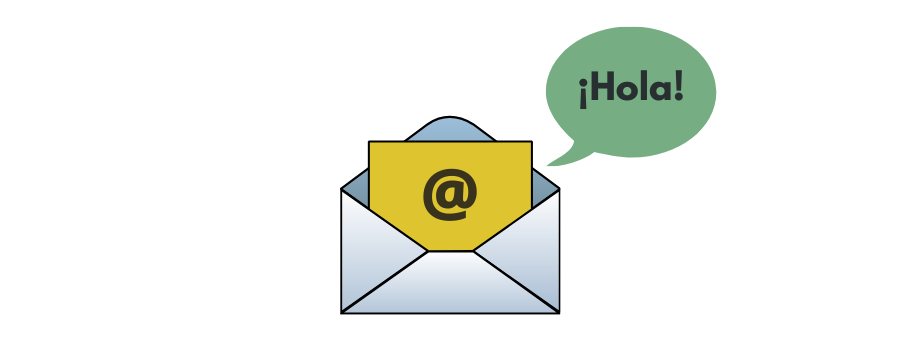How to Write an Email in Spanish: the complete guide
As you learn Spanish and engage with the Spanish-speaking world, you may find yourself needing to write an email in Spanish. This guide is here to make that process easier for you.

Levels of formality in Spanish
Spanish has two second-person pronouns: “tú” for informal situations, and “usted” for formal situations. The choice of pronoun affects verb conjugation.
| Tú | Usted | You |
| Quieres | Quiere | Want |
| Amas | Ama | Love |
| Eres | Es | Are (permanently) |
| Estás | Está | Are (temporarily) |
Additionally, the two “you’s” in Spanish are related to two different possessive adjectives meaning “your”:
- “tu” (without an accent or tilde) is used when you’re addressing the person as “tú”.
- “su” is used when you’re addressing the person as “usted”.
The indirect objects (meaning “to you”) also vary:
- “te” (without an accent or tilde) is linked to the informal second-person pronoun
- “le” is linked to the formal second-person pronoun.
For example:
| Formal (usted) | Informal (tú) |
| Le escribo este email para enviarle los documentos que me solicitó (I’m writing this email [to you] to send you the documents that you asked me) | Te quería contar que me fue bien en el examen de español (I wanted to tell you that I did well on the Spanish test). |
| Uno de sus empleados me dio su dirección de email (one of your employers gave me your email address) | Vi a uno de tus amigos en la fiesta de Navidad (I saw one of your friends at the Christmas party) |
As in other languages, the level of formality is given by the relationship that you have with that person.
“Usted” is generally used when you talk to authority figures, such as employers and professors, or when you talk to people you don’t know (especially if they’re much older than you).
“Tú” is used with friends and family members, coworkers of the same rank, and people of the same age (especially young people may feel weird and older than they are if you address them as “usted” in the streets).
So as you can see, the way you’ll write your email in Spanish will vary depending on who the receiver is.
How to start an email in Spanish
Formal email greetings in Spanish
The most common formal email opening line is “Estimado/a Sr./Sra [last name]”. “Sr.” or “Sra.” are abbreviations of “señor” and “señora”, just like in English we’d write “Mr.” or “Mrs.”
Just like in English, Spanish-speaking people use “señor” or “señora” (or their abbreviations) according to the person’s gender. So, if you’re writing an email to a woman —let’s say her name is Marina López—, you want to write “Estimada señora López” in your formal email in Spanish.
It’s important that you use “estimado” or “estimada” and not “querido” and “querida”. Although many dictionaries may list them as synonyms, “querido” is a more affectionate term that is more common in informal contexts and less appropriate for formal emails.
An alternative to this is writing directly “señora López:” but it may sound a little curt in some contexts.
If you don’t know the person’s last name but you know their profession or their role in a company, you can write “Estimado(a)” + the role or the profession. For example, “Estimado(a) director(a)” or “Estimado(a) profesor(a)” (Dear director/Dear professor).
If you don’t really know who you’re writing to, you can use “A quien corresponda”, which means “to whom it may concern”.
Informal email opening lines in Spanish
Remember what we’ve clarified about the word “querido” or “querida”? “Querido” or “querida” are more common in informal email greetings, and they’re usually followed by the person’s first name instead of his or her last name.
So if you’re a friend of Marina López, you’d write “querida Marina” as an email opening line. “Buenos días”, “buenas tardes”, and “buenas noches” (good morning, good afternoon, and good evening) are also acceptable.
If you’re a really close friend or family member, you can use an even more informal tone marked by the presence of casual greetings like “hola” (hello) and “buenas” (short for “buenos días/tardes/noches”).
The body of your email in Spanish
Right after the greeting, you should start explaining who you are and/or why you’re writing that email. Especially in formal emails, you want to get to the point quickly without sounding too abrupt. Key phrases, in this case, could be:
| Spanish | English |
| Me llamo/Mi nombre es… | I am… / My name is… |
| Le escribo porque… | I’m writing [to you] because… |
| Me dirijo a usted a causa de… | I’m approaching you because… |
| Me dirijo a usted para solicitarle… | I’m approaching you to ask you for… |
| Le molesto para… | I’m bothering you to/because… |
| Le contacto para… | I’m contacting you to/because… |
| Me gustaría saber si… | I would like to know if… |
| Quisiera informarle sobre/acerca de… | I would like to inform you that… |
| Me gustaría recibir información sobre/acerca de… | I would like to receive information about… |
Please, note that “me gustaría” and “quisiera” can both be translated as “I would like [to]”.
- “Me gustaría” is the option that is closer to the English verb “like”
- “quisiera” comes from the verb “querer”, which is Spanish for “want”
Although these verbs have different meanings, they are practically interchangeable when you are asking for something.
Also note that “molestar” is used in a humble way here, like a way to excuse yourself for the time that you’re “stealing” from the other person. If you’d like to really apologize, though, you want to use “disculpe las molestias” (“sorry to bother you”). This could be more suitable if you are asking for a favor from somebody you are not familiar with.
So what do you say after that? What would you like to do with your email, or what do you want to obtain from your receiver? What you can say really depends on the specific case, but here are some examples to give you ideas.
| Spanish | English |
| Me gustaría postularme para el puesto de… | I would like to apply for the position of… |
| Aquí le envío los documentos que me pidió. | Here, I’m sending you the documents that you asked me for. |
| Por favor, mire el archivo adjunto. | Please, take a look at the attachment. |
Informal emails allow other phrases in a more direct and personal tone. Pay attention to the differences in the conjugation of the verbs in relation to the second-person pronoun “tú”:
| Spanish | English |
| ¿Cómo estás? | How are you? |
| ¿Puedes enviarme el archivo cuanto antes? | Can you send me the file ASAP? |
| Te avisaré si recibo alguna noticia. | I will let you know if I receive any updates. |
| Aquí está el archivo que me pediste. | Here’s the file that you asked me for. |
| Muchas gracias por tu ayuda. | Thank you very much for your help. |
The more direct and literal translation of letting someone know something is “dejarle saber [algo a alguien]” but this phrase doesn’t sound natural in Spanish. Use the verb “avisar” instead. Don’t worry, it has essentially the same meaning (but in only one word).
How to finish an email in Spanish
Formal email closing lines in Spanish
Formal email closing lines in Spanish have equivalent phrases in English, but you should never directly translate these phrases from English to Spanish because some of them may not sound natural in Spanish.
For example, “sincerely” can be literally translated as “sinceramente”, but this is not a word that Spanish speakers would normally use at the end of a formal email.
Instead, they would use “atentamente” or the abbreviated form “atte.” right before the signature. Or “le saluda atentamente/cordialmente”, which means “greeting you attentively/sincerely/cordially”.
Other closing lines in Spanish are “saludos cordiales” (basically meaning “best regards”) or phrases that express gratitude (for taking the time of reading the email, for considering assisting you in what you’re asking, etc.).
Here are some ways of writing this:
| Spanish | English |
| Gracias de antemano | Thank you in advance |
| Muchas gracias | Thank you very much |
| Le agradezco de antemano por su ayuda | I thank you in advance for your help |
Informal email closing lines in Spanish
| Spanish | English |
| Un saludo or saludos | Cheers |
| Besos | Kisses |
| Un abrazo | A hug |
| Te veo el martes / Nos vemos el martes | See you on Tuesday |
| Nos vemos pronto | See you soon |
| Nos vemos luego / Nos vemos más tarde | See you later |
| Nos estamos viendo | See you around |
| Con cariño / Cariñosamente | Affectionately |
| Con amor | With love |
| Cuídate | Take care of yourself |
As always, if you forgot any details, you can write “P.D.” at the end of your email, which means “post data”. This is Spanish for “postscript” or “P.S.” and works both for formal and informal emails.
